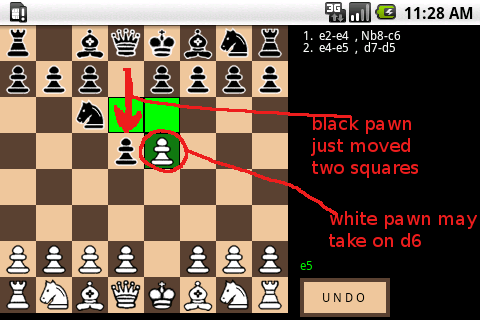



It’s not like capturing en passant is inherently bad, but – as always in chess – you need to evaluate if a certain move improves or worsens your position ⚖️. We can now capture the pawn as if it had only moved forward one square.Įven though en passant is a pretty nifty move, don’t be tempted to blindly capture en passant when given the chance.The enemy pawn advanced two squares, placing it directly next to our pawn.Our pawn is on the 5th rank, with an enemy pawn on the 7th rank (and yet to make its first move) on a horizontally adjacent file.Capturing en passant could look something like this: White Captures the Advancing Black Pawn “En Passant” Meaning, you lose your right to capture en passant if you do not immediately exercise it ❌. However, this special move is only allowed on the turn immediately after the enemy pawn’s two-square advance. If (and only if) these three rules are met, you can immediately capture the enemy’s pawn as if it only moved forward one square. The enemy pawn moved two squares on the previous move.Both pawns must occupy adjacent files (i.Both pawns must occupy the same rank (i.There are three rules that need to be met to be allowed to capture a pawn en passant:
#En passant rule how to
Let’s break it down so you actually understand how to capture en passant. That’s exactly how FIDE describes en passant in their official rulebook of chess. This capture is only legal on the move following this advance and is called an ‘en passant’ capture.” “A pawn attacking a square crossed by an opponent’s pawn which has advanced two squares in one move from its original square may capture this opponent’s pawn as though the latter had been moved only one square. Ready for a boring description of en passant? Here you go: Asian chess variations do not include any of these moves.En passant is the only time where the capturing piece does not end up in the square it captured the enemy piece from. Due to their isolation from European chess prior to that time. The rule specifically permits a pawn on a player’s fifth rank to capture an opponent’s pawn on an adjacent file that moves two squares on its first move as if it had only progressed one square (Davidson 1949:16). One created En Passant to prevent the use of the traditional and old two square method. One didn’t accept it widely until the Italians changed the rules in 1880. Hence, The people initially accepted the rule in 1880 but on a small scale. Spanish master Ruy López de Segura explains the rule (Golombek 1977:108). In his 1561 book Libro de la invencion liberal y arte del juego del axedrez. Along with the two-square first move for pawns, castling, and queens and bishops having an unrestricted range (Davidson 1949:14,16,57). History Of The En Passant RuleĪllowing en passant capture was one of the last significant rule changes in European chess between 12. The exception to this rule is en passant. Importantly, the pawns can’t move backward. A pawn must move one square diagonally if it wishes to take another piece. The piece can even move two squares forward from its starting position if desired.


 0 kommentar(er)
0 kommentar(er)
